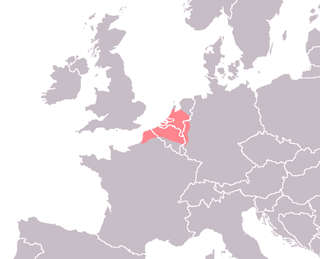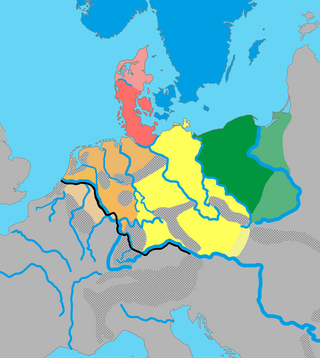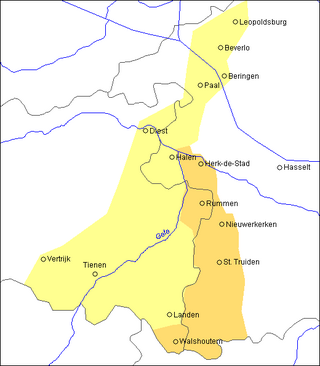Related Research Articles
The High German languages, or simply High German – not to be confused with Standard High German which is commonly also called "High German" – comprise the varieties of German spoken south of the Benrath and Uerdingen isoglosses in central and southern Germany, Austria, Liechtenstein, Switzerland, Luxembourg, and eastern Belgium, as well as in neighbouring portions of France, Italy, the Czech Republic (Bohemia), and Poland. They are also spoken in diasporas in Romania, Russia, Canada, the United States, Brazil, Argentina, Mexico, Chile, and Namibia.

Low Saxon, also known as West Low German are a group of Low German dialects spoken in parts of the Netherlands, northwestern Germany and southern Denmark. It is one of two dialect groups, the other being East Low German.

Stadsfries or Town Frisian is a set of dialects spoken in certain cities in the province of Friesland in the northern Netherlands, namely Leeuwarden, Sneek, Bolsward, Franeker, Dokkum, Harlingen, Stavoren, and to some extent in Heerenveen. For linguistic reasons, the outlying and insular dialects of Midsland (Terschelling), Ameland, Het Bildt, and Kollum are also sometimes tied to Stadsfries.

Limburgish, also called Limburgan, Limburgian, or Limburgic, is a West Germanic language spoken in the Dutch and Belgian provinces of Limburg and in the neighbouring regions of Germany.

Ripuarian is a German dialect group, part of the West Central German language group. Together with the Moselle Franconian which includes the Luxembourgish language, Ripuarian belongs to the larger Central Franconian dialect family and also to the Rhinelandic linguistic continuum with the Low Franconian languages.

Hollandic or Hollandish is the most widely spoken dialect of the Dutch language. Hollandic is among the Central Dutch dialects. Other important language varieties of spoken Low Franconian languages are Brabantian, Flemish, Zeelandic, Limburgish and Surinamese Dutch.

East Flemish is a collective term for the two easternmost subdivisions of the so-called Flemish dialects, native to the southwest of the Dutch language area, which also include West Flemish. Their position between West Flemish and Brabantian has caused East Flemish dialects to be grouped with the latter as well. They are spoken mainly in the province of East Flanders and a narrow strip in the southeast of West Flanders in Belgium and eastern Zeelandic Flanders in the Netherlands. Even though the dialects of the Dender area are often discussed together with the East Flemish dialects because of their location, the latter are actually South Brabantian.

West-Veluws is a Low Saxon dialect of the Dutch province of Gelderland. It is spoken in several Veluwe municipalities and villages including: Nunspeet, Putten, Ermelo (Armelo), Harderwijk (Harderwiek), Uddel, Nijkerk (Niekark), Appel, Scherpenzeel (Schaarpezeel), the municipality of Barneveld (Barreveld) and some villages of the municipality of Ede.
Sallaans is a collective term for the Westphalian dialects of the region Salland, in the province of Overijssel, as well as in minor parts of Gelderland and Drenthe in the Eastern Netherlands. In the Kop van Overijssel, the Stellingwarfs dialect is spoken.

In linguistics, Old Dutch or Old Low Franconian is the set of Franconian dialects spoken in the Low Countries during the Early Middle Ages, from around the 6th or 8th to the 12th century. Old Dutch is mostly recorded on fragmentary relics, and words have been reconstructed from Middle Dutch and Old Dutch loanwords in French.
Southeast Limburgish is a cover term for the Ripuarian dialects spoken in Dutch Limburg.

The predominant language of the Netherlands is Dutch, spoken and written by almost all people in the Netherlands. Dutch is also spoken and official in Aruba, Bonaire, Belgium, Curaçao, Saba, Sint Eustatius, Sint Maarten and Suriname. It is a West Germanic, Low Franconian language that originated in the Early Middle Ages and was standardised in the 16th century.
Dutch dialects are primarily the dialects that are both cognate with the Dutch language and spoken in the same language area as the Dutch standard language. They are remarkably diverse and are found within Europe mainly in the Netherlands and northern Belgium.

Dutch is a West Germanic language spoken by about 25 million people as a first language and 5 million as a second language. It is the third most widely spoken Germanic language, after its close relatives English and German. Afrikaans is a separate but somewhat mutually intelligible sister language of modern Dutch, and a daughter language of an earlier form of Dutch. It is spoken, to some degree, by at least 16 million people, mainly in South Africa and Namibia, evolving from the Cape Dutch dialects of Southern Africa. The dialects used in Belgium and in Suriname, meanwhile, are all guided by the Dutch Language Union.

Friso-Saxon is a group of West Germanic dialects found around the North Sea coast of the Netherlands and Germany, in an area historically known as Frisia. They are dialects of Low German/Low Saxon that have experienced strong influence from a Frisian language.

In historical linguistics, the Ingvaeonic nasal spirant law is a description of a phonological development that occurred in the Ingvaeonic dialects of the West Germanic languages. This includes Old English, Old Frisian, and Old Saxon, and to a lesser degree Old Dutch.

Flemish (Vlaams) is a Low Franconian dialect cluster of the Dutch language. It is sometimes referred to as Flemish Dutch, Belgian Dutch, or Southern Dutch. Flemish is native to the region known as Flanders in northern Belgium; it is spoken by Flemings, the dominant ethnic group of the region. Outside of Belgium Flanders, it is also spoken to some extent in French Flanders and the Dutch Zeelandic Flanders.

Provincial elections were held in the Netherlands on 20 March 2019. Eligible voters elected the members of the Provincial States in the twelve provinces of the Netherlands. The elections were held on the same day as the 2019 Dutch water boards elections and, in the Caribbean Netherlands, island council elections.

Getelands or West Getelands is a South Brabantian dialect spoken in the eastern part of Flemish Brabant as well as the western part of Limburg in Belgium. It is a transitional dialect between South Brabantian and West Limburgish.
References
- 1 2 3 4 5 6 7 8 9 10 Wilbert (Jan) Heeringa, Chapter 9: Measuring Dutch dialect distances, of the doctor's thesis: Measuring Dialect Pronunciation Differences using Levenshtein Distance, 2004 (thesis, chapter 9 (PDF))
- ↑ Wilbert Heeringa, John Nerbonne, De analyse van taalvariatie in het Nederlandse dialectgebied: methoden en resultaten op basis van lexicon en uitspraak, 2006 (, )